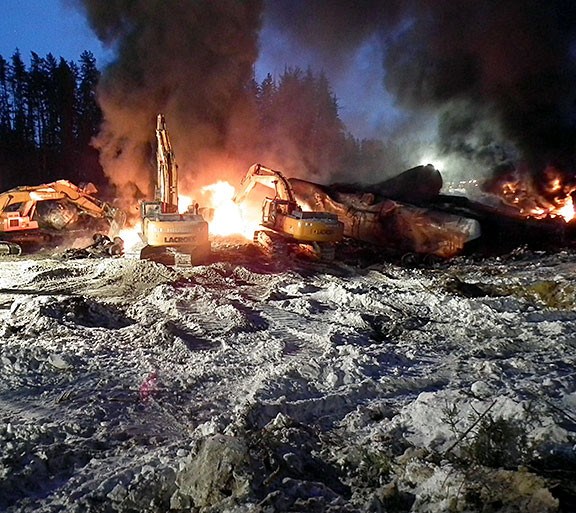A federal investigation into the first of two northeastern Ontario train derailments in 2015 points to track maintenance and posted track speeds as contributing factors in the fiery crash.
The Transportation Safety Board of Canada (TSB) issued a recommendation calling for Transport Canada to develop strategies to reduce the severity of derailments involving dangerous goods.
The recommendation emerged from the watchdog agency’s investigation into the February 2015 derailment and fire involving a Canadian National Railway (CN) crude oil unit freight train near Gogama.
The TSB released the findings at a press conference in Sudbury on Feb. 16, just a couple of days past the two-year anniversary of the incident.
The report was on the first of two derailments that took place near Gogama on CN’s Ruel Subdivision just weeks apart in early 2015.
"This accident occurred at a speed below the maximum speed permitted by the Transport Canada approved Rules Respecting Key Trains and Key Routes," said TSB chair Kathy Fox in a statement. "The TSB is concerned that the current speed limits may not be low enough for some trains—particularly unit trains carrying flammable liquids,” said Fox. “We are also calling for Transport Canada to look at all of the factors, including speed, which contribute to the severity of derailments, to develop mitigating strategies and to amend the rules accordingly."
A key route means any track which handles 10,000 or more loaded tank cars or cars loaded with dangerous goods over the course of a year.
A key train means an engine pulling one or more loaded tank cars carrying dangerous goods.
On Feb. 14, 2015, an eastbound CN unit train with 100 tank cars loaded with petroleum products derailed. It was travelling at 38 miles per hour (mph), below the 40 mph speed limit in place at the time.
Twenty-nine of those cars went off the track and 19 were breached, releasing 1.7 million litres which ignited fires that burned for five days. There were no injuries.
The TSB determined that speed had a direct impact on the severity of the tank-car damage.
The investigation also revealed that the derailment occurred when joint bars in the track failed.
Pre-existing fatigue cracks in the joint bars at this particular track location had gone unnoticed in previous inspections.
Once the cracks reached a critical size, the combination of the cold temperatures (-31 C) and repetitive impacts from train wheels passing over the joint caused the joint bars to fail, said the TSB.
The agency further determined that the assistant track supervisor received “insufficient” training, on-the-job mentoring and supervisory support.
Although the tank cars were Class 111s and built to the upgraded post-Lac-Mégantic standard, the TSB said the CPC-1232 standard requires the cars to have additional protective equipment.
The lack of thermal protection contributed to punctures in the cars located in the fire pool, which caused additional oil to release.
“Consequently, the cars displayed similar performance issues as in the Lac-Mégantic derailment,” said the TSB in a news release.
"The Transportation of flammable liquids by rail has been on the TSB Watchlist since 2014," added Fox. "While stronger tank cars are being built, the current ones will be in service for years to come. The risks will also remain until all of the factors leading to derailments and contributing to their severity are mitigated. This is the focus of the recommendation we issued today."
Just weeks later on March 7, a second CN train hauling 94 cars of crude oil went off the tracks three west of Gogama near a rail bridge that spanned the Makami River.
Some cars plunged into the river with a number being punctured that started a large pool of fire which destroyed the bridge and 700 feet of track. That second incident remains under investigation by the TSB. At the time, it was the third derailment in Northern Ontario in less than a month.




